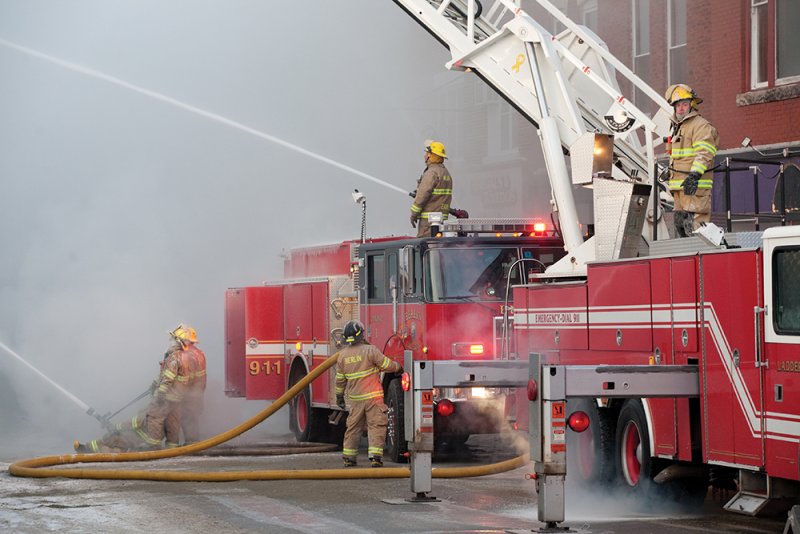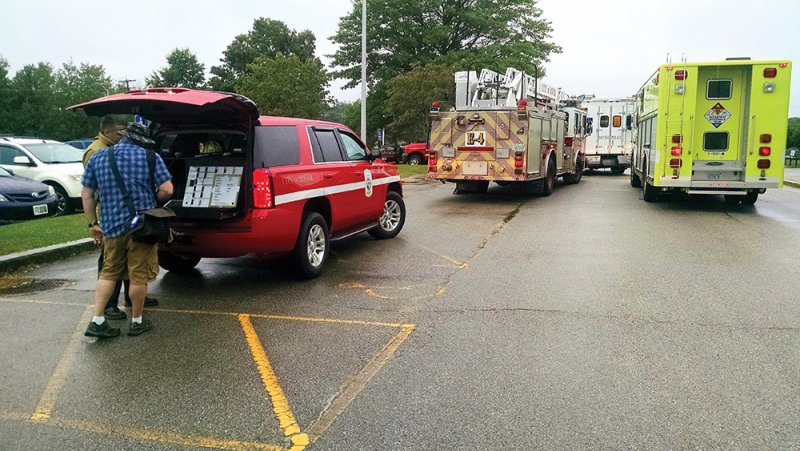
Berlin Fire Department personnel at the scene of a fire. Courtesy photo.
As voters head to town meetings this month and cities finalize their budgets, they will make decisions on whether to approve requests for major expenditures, including new fire engines and other emergency vehicles and equipment.
Even when a community puts the purchase into a capital improvement plan and saves for it over time, getting the final go-ahead from voters for an item that may cost half a million dollars isn’t always easy.
But the assortment of tankers, ladder trucks, ambulances and command vehicles are not just on a fire chief’s wish list. These items, along with staffing levels for firefighters and EMTs, also help determine the cost of insurance for the town, local businesses and even residents.
Every community has an agency protection class rating used by the insurance industry to set rates based on the “Standard for the Organization and Deployment of Fire Suppression Operations, Emergency Medical Operations, and Special Operations to the Public by Career Fire Departments.” The standard is set by the National Fire Protection Agency (NFPA), which was founded in the late 1800s to improve fire protection and prevention methods, and establish proper safeguards against loss of life and property through standards or codes.
How well a community meets these codes determines its protection class (PC) ratings. The terrain, size, and infrastructure, of a community, such as large mills or skyscrapers, are considered when determining what a community needs for emergency response equipment and staffing.
For example, to meet national standards, the city of Dover, which has a population of 31,398 and encompasses 29.03 square miles, needs to have 15 to 17 firefighting staff who can arrive within eight minutes of dispatch to a fire, says Dover Fire Chief Eric Hagman. “This standard is based on science that has determined that 15 to 17 firefighting staff is the proper amount to complete all initial job tasks at a fire,” he says, adding that Dover meets those numbers by having 13 staff and chief-level command staff on duty.
The ratings factored into the city’s decision to have a combined fire and rescue department, rather than outsource it to EMS as nearby communities do. Hagman says without the ambulance crews, there would be just nine fire staff on duty instead of 13, and even with the command staff added, they would come up short by four people. “So that is two less hose lines or two less search crews that are available at a fire,” he says.
Determining Ratings
Hagman says many communities aren’t aware that the national rating service, International Organization for Standardization (ISO), now rates their fire service’s effectiveness every five years and has started measuring the degree of compliance toward NFPA 1710.
Dover’s ISO rating is high due to its hydrant coverage and its compliance to NFPA 1710, Hagman says. “By providing 911 EMS, Dover benefits in many ways, ranging from that initial point of contact by an advanced medical provider to a higher ISO rating, which means lower fire insurance rates for each and every property owner in Dover,” he says.

Dover Fire and Rescue vehicles responding to a hazardous materials call. Courtesy photo.
In the city of Berlin, where the economics are bit more challenging, Fire Chief John Lacasse says they rely, in part, on the mutual aid system and an older but well-maintained fleet. The city has four pumpers, one ladder and a tanker, with the average age being 25 years. Currently the city’s ISO score is 4. (The ratings range from 10 to 1, with 1 being the best.)
He says having a ladder truck is especially important because the city has several three- and four-story tenements on hills, so the 100-foot reach is critical. And, while Berlin is not part of the mutual aid district in Coos County called NorthPac, it does have mutual aid agreements with the towns of Milan and Gorham.
In addition to the community rating; insurance carriers can further rate individual structures. Rick Brownell Jr., general manager of Brownell Insurance in Londonderry and Hampton, says the three main criteria considered for individual properties are the type of structure, distance to a fire station, and distance to a hydrant. For example, a wood-frame house with a restaurant on the ground floor might not even get coverage and could automatically be declined.
As for determining a home’s rating prior to purchase, Brownell says that while ratings are not published, a home buyer can ask the town, a real estate or insurance agent. That information could prevent an insurance headache down the road. “A friend bought a house on a lake that was more than five miles from a station and had no hydrants,” Brownell says, adding that the home also had limited accessibility. Those factors led to it scoring a 9 for its protection class rating. “Some insurance carriers flat-out declined. They felt if this house caught fire, it would burn to the ground,” he says.
Brownell says there are ways to mitigate the risk, including installing sprinklers and a fire alarm system that automatically alerts the fire department, which can save precious minutes in reaching a home in a rural setting.

 Current Issue - April 2024
Current Issue - April 2024